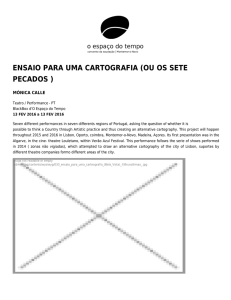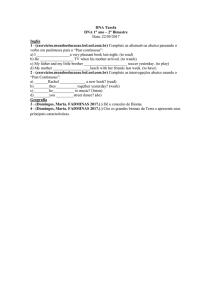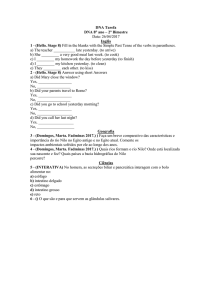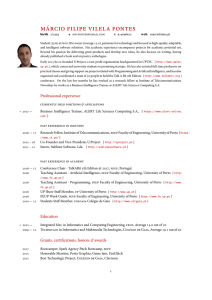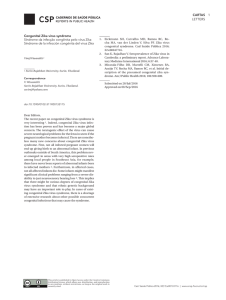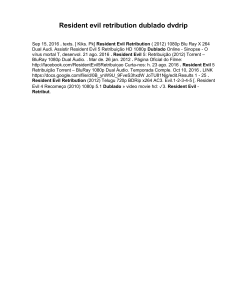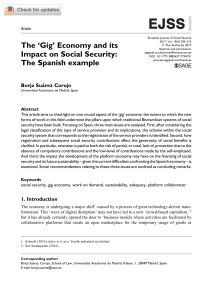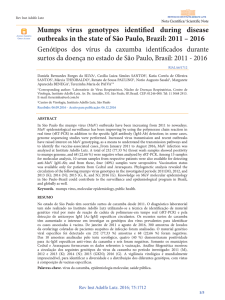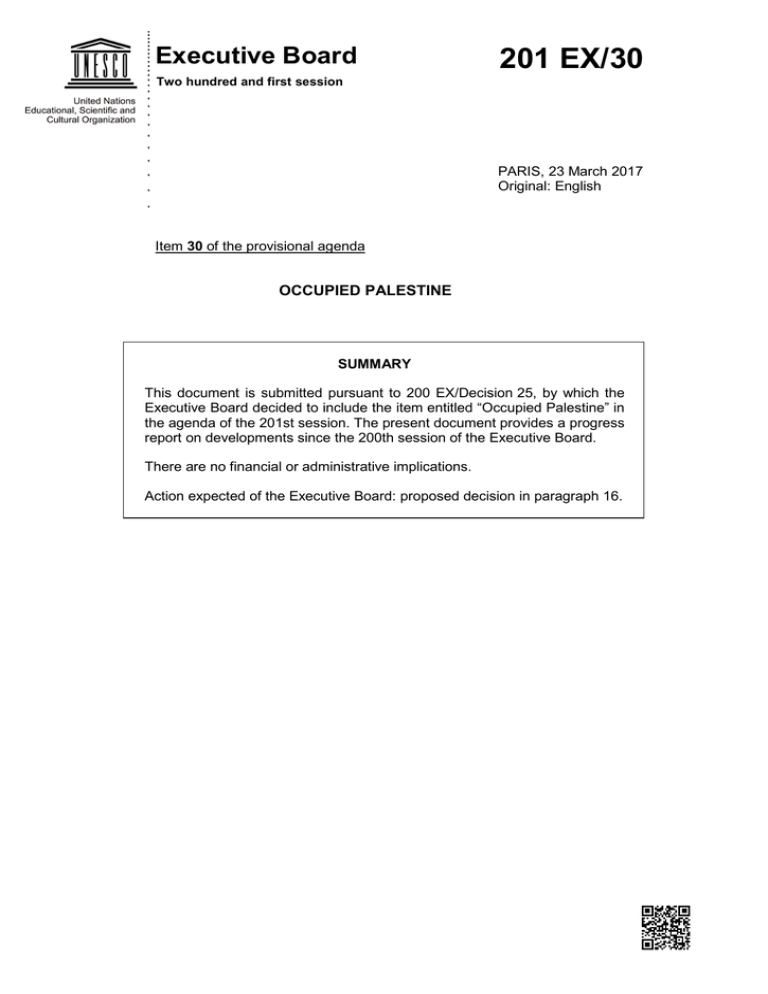
Executive Board
201 EX/30
Two hundred and first session
PARIS, 23 March 2017
Original: English
Item 30 of the provisional agenda
OCCUPIED PALESTINE
SUMMARY
This document is submitted pursuant to 200 EX/Decision 25, by which the
Executive Board decided to include the item entitled “Occupied Palestine” in
the agenda of the 201st session. The present document provides a progress
report on developments since the 200th session of the Executive Board.
There are no financial or administrative implications.
Action expected of the Executive Board: proposed decision in paragraph 16.
201 EX/30
I.
Old City of Jerusalem and its Walls
1.
The state of conservation of the Old City of Jerusalem and its Walls (site proposed by
Jordan) is the subject of regular reporting to the Executive Board and to the World Heritage
Committee. It was examined by the World Heritage Committee at its 40th session in Paris in
October 2016. The 15th Reinforced Monitoring Report dated April 2016 on the Old City of
Jerusalem and its Walls was sent to all World Heritage Committee members.
2.
Pursuant to 176 EX/Special Plenary Meeting and to the decisions of the Executive Board and
the World Heritage Committee since 2007, the World Heritage Centre has spared no efforts to
facilitate exchanges between Israeli, Palestinian, Jordanian and Waqf experts regarding the design
of the Mughrabi Ascent in the Old City of Jerusalem, as well as to facilitate the UNESCO Reactive
Monitoring Mission to the Old City of Jerusalem and its Walls and a UNESCO experts meeting on
the Mughrabi Ascent.
3.
However, at the time of the preparation of this document, the monitoring mission and experts
meeting requested by the Executive Board and by the World Heritage Committee could not be
undertaken.
4.
On 15 July 2016 and on 14 October 2016, the Director-General issued statements on the Old
City of Jerusalem and its Walls, recalling that as per its inscription on the World Heritage list, the
Old City of Jerusalem is the sacred city of the three monotheistic religions – Judaism, Christianity
and Islam, and that each of its communities has a right to the explicit recognition of their history
and relationship with the city. She referred to the Al-Aqṣà Mosque/al-Ḥaram al-Sharīf, holy site to
Muslims, also revered by Jews as the Har HaBayit or Temple Mount, a few steps away from the
Church of the Saint Sepulcher revered in Christianity, as testimony to the spiritual significance of
Jerusalem as a microcosm of humanity’s diversity and, in itself, “an appeal for dialogue, not
confrontation”.
5.
By letters dated 10 and 22 November 2016, the Permanent Delegation of Palestine, referring
to the Old City of Jerusalem and its Walls, expressed concerns regarding reported modifications of
monuments, streets and squares names as well as reported “damages to the Bab Al Rahma
cemetery, adjacent to the eastern wall of the Al-Aqṣà Mosque/al-Ḥaram al-Sharīf”. By letter dated
19 January 2017, the Secretariat has forwarded these concerns to the Permanent Delegation of
Israel to UNESCO, and asked the latter to provide more information in this regard. By letter dated
14 March 2017, the Permanent Delegation of Israel refuted these complaints as “repetitive and
falsified”.
6.
Following the agreement signed between UNESCO and the Norwegian Government in
December 2011 on the project for “Ensuring the sustainability of the Centre for the Restoration of
Islamic Manuscripts of the Haram al-Sharif in Jerusalem”, UNESCO has deployed its assistance to
build the Centre’s staff capacities in the preservation of Islamic manuscripts. Since the outset of
the project, five additional staff have been recruited for the Centre and 12 training sessions totalling
1,370 hours of teaching on conservation and restoration techniques have been held so far, in
addition to study tours to restoration centres in Paris and Florence in 2013. The project also
provided the Centre with conservation equipment and materials. UNESCO conducted four
consultation missions in 2014/15. The stakeholders are currently discussing a possible new phase
of the project to be implemented from 2017 onwards.
7.
The refurbishment of the Islamic Museum in the Haram Al-Sharif and its Collection, funded
by Saudi Arabia, is currently on hold pending additional funding to complete the proposed
museographical and scenographical planning, which was approved in March 2015 by the Awqaf
authorities. A follow-up mission took place in June 2015. The re-opening of the Museum will
depend on the availability of additional funds, and is foreseen beyond 2017.
8.
By letter dated 6 December 2016, the Permanent Delegation of Palestine to UNESCO
expressed concerns following reports that part of the collections of the Rockefeller Museum
201 EX/30 – page 2
located in East Jerusalem had been transferred to West Jerusalem. The Secretariat has forwarded
these concerns to the Permanent Delegation of Israel to UNESCO, and asked the latter for more
information. The Permanent Delegation of Israel refuted these complaints as “repetitive and
falsified”.
9.
Should additional information become available to the Secretariat regarding the abovementioned matters, the Director-General is prepared to publish an Addendum to this document
before the 201st session of the Executive Board in order to inform the Members of the Executive
Board of any new developments in that regard.
II.
A.
Reconstruction and development of Gaza (July 2016 – January 2017)
Education
10. UNESCO continues to support vulnerable university students in Palestine in two Community
Libraries in the Gaza Strip, funded by the Saudi Committee for the Relief of Palestinian People,
through the provision of study and research library facilities, textbooks and other resource
materials. Since the last reporting period, the libraries have continued to increase the number of
beneficiaries to approximately 4000 students.
11. UNESCO also continued its support to inclusive and child-friendly education, through piloting
child-led activities and innovative teaching/learning methods, targeting 19 additional schools
benefiting an additional number of 772 children and 50 teachers and supervisors in the Gaza Strip.
Culture
12. UNESCO successfully completed the rehabilitation of the historic monument in Al-Khader
shrine in Deir Albalah. The site is currently reused by a community children library benefiting more
than 500 vulnerable children and providing community services for the neighbourhood. The site
had been abandoned and partially damaged during the 2014 war in Gaza. The project contributed
to the local development in the target community by generating 1500 working days and provided a
highly demanded social service for children.
13. UNESCO continued to support the safeguarding and promotion of the archaeological site of
Tell um Amer/Saint Hilarion Monastery in Gaza Strip, which is included on the Tentative List of
Palestine for possible nomination to the World Heritage List. Monitoring missions were carried out
in September and in November 2016 to assess the state of conservation of the site after an
attempted break into the site. The mission identified damage in the new protection fence around
the site, which had been installed by UNESCO in Spring 2016, as well as in the retaining sand
bags used to support the structures in the baptistery and the church areas. Minor damage to two
mosaics panels was also reported. UNESCO is now carrying out relevant conservation and
consolidation measures as well as site maintenance works. Information signs to highlight the
archaeological features and the importance of the preservation of this unique site will be also
installed. The site is suffering from gradual erosion and degradation due to climatic conditions and
the lack of necessary protection. In addition, the lack of funds impedes the implementation of
required overall conservation, management and promotion of the site. UNESCO continues its
efforts to raise funds in this regard, with the preparation of relevant project proposal and the
organization of field visits to the site and to other vulnerable cultural heritage sites in Gaza Strip.
B.
The two Palestinian sites of al-Ḥaram al-Ibrāhīmī/Tomb of the Patriarchs in
al-Khalīl/Hebron and the Bilāl ibn Rabāḥ Mosque/Rachel’s Tomb in Bethlehem
14. This matter has been on the agenda of the Executive Board since its 184th session at the
request of a number of Member States, in relation to the decision of the Israeli authorities,
201 EX/30 – page 3
announced in February 2010, to include the two above-mentioned sites located in Hebron and
Bethlehem in Israel’s National Heritage Programme.
15. By letter dated 17 November 2016, the Permanent Delegation of Palestine to UNESCO
expressed concerns regarding reported construction works in the Old City of Hebron, which may
endanger the site. By letter dated 18 January 2017, the Permanent Delegation of Palestine to
UNESCO expressed concerns regarding alleged illegal excavations in Tel Rumeida – Al
Khalil/Hebron. The Secretariat forwarded these concerns to the Permanent Delegation of Israel to
UNESCO, and asked the latter to provide more information in this regard. The Permanent
Delegation of Israel refuted these complaints as “repetitive and falsified”.
Proposed decision
16.
The Executive Board may wish to adopt a decision along the following lines:
The Executive Board,
1.
Recalling previous decisions concerning “Occupied Palestine”,
2.
Having examined document 201 EX/30,
3.
Decides to include this item in the agenda of its 202nd session, and invites the
Director-General to submit to it a follow-up report thereon.
Printed on recycled paper

